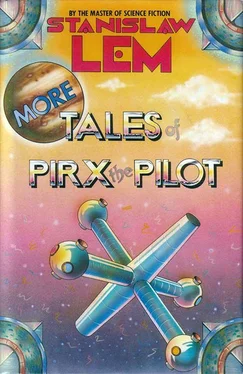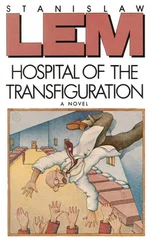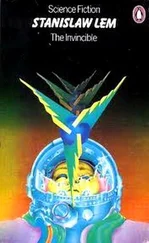The simulator, itself a computer, also played the role of “examiner,” and a perfidious one at that, subjecting the already programmed “pupil” to further endurance and efficiency tests, so that, although in actuality the electronic navigator had never piloted a ship, by the time it was finally installed aboard ship, it was more experienced, more flightworthy than the sum total of professional navigators. That is, the problems simulated during the bench-testing phase were too complex ever to occur in reality. And just to safeguard against the slightest imperfection, the pilot-simulator’s performance was monitored by a human, an experienced programmer with years of flight training behind him; Syntronics didn’t bother with pilots, only with astronauts at the rank of navigator or better, only with those, in other words, who had already logged a minimum of a thousand hours. With them rested the final decision as to which test, out of an inexhaustible range, the computer would be made to undergo next. The systems analyst specified the testing level and, by manipulating the simulator, further complicated the “exams” by simulating sudden—and potentially lethal—power blowouts, flare-outs, collision alerts, skin ruptures, communication breakdowns with ground telemetry … until the minimum standard of a hundred bench-testing hours had been achieved. Any model showing the slightest fallibility was sent back to the shop, like a flunked student who has to repeat a year.
Having in effect placed the shipyards beyond reproach, Van der Voyt, probably to counteract the impression of partiality, made an eloquent plea for an impartial inquiry. Next, a team of experts from Earth took the floor, thereupon unleashing a torrent of scientific parlance, flow charts, block diagrams, formulas, models, and statistical comparisons; and Pirx was chagrined to see that they were well on their way to turning the whole affair into an abstruse theoretical case study. The senior computer scientist was followed by Schmidt, the project’s systems engineer. Pirx very soon switched off, not bothering to stay alert for another round with Van der Voyt, which seemed progressively less likely. Not one reference was made to his own pronouncements, as if he had committed a faux pas —and the sooner it was forgotten, the better. By now they had reached the highest pinnacle of navigational theory. Pirx did not suspect them of malice; prudence dictated that they stay close to home. Throughout, Van der Voyt sat and listened indulgently. The strategy had worked: Earth was dominating the hearing. The “Martians” had been reduced to passive spectators; they had no surprise revelations up their sleeves. The Ariel’s computer was now electronic scrap, totally worthless as a source of clues. The tapes may have conveyed the what, more or less, but not the why. Not everything inside a computer can be monitored: one would need another, more powerful, computer, which, to be made foolproof, would again have to be monitored by yet another, and so on ad infinitum.
Thus were they cast adrift on a sea of abstraction. The profundity of the disquisitions only obscured the fact that the tragedy extended far beyond the shipwreck of the Ariel. Automatic sequencers had been around for so long that they had become the basis, indeed, the inviolable premise, of all landing operations, and now this was on the verge of being snatched away. If none of the simpler, less foolproof computers had ever malfunctioned, why should a perfected, more sophisticated one fail? If that was possible, anything was possible. If the computer’s fallibility was open to doubt, there was no stopping the erosion of faith; then everything became mired in skepticism.
Meanwhile, the Ares and Anabis were Mars-bound. Pirx felt alone, on the brink of despair. The inquest into the Ariel had given way to a classic argument between theoreticians, and it was leading them further and further afield. As he looked up at Van der Voyt’s bloated, overblown face benevolently patronizing the committee, Pirx was suddenly struck by its resemblance to Churchill’s: the same look of apparent distraction, belied by a slight twitching of the mouth, betraying an inner smile provoked by a thought lurking behind heavy eyelids. What yesterday seemed unthinkable was now a foregone conclusion: a move to shift the burden of blame onto some higher force, onto the unknown, perhaps, or onto some theoretical omission, one that would require more extensive, long-term research. Pirx knew of similar, though less sensational cases, and knew the sort of passions such a disaster could arouse. Intensive efforts were already under way to reach a face-saving compromise, especially since the project, with its very existence now at stake, was ready to make concessions in exchange for support of the sort the shipyards could provide, if only by supplying a fleet of smaller cargo ships on favorable terms. In view of the high stakes—namely, the project’s survival—the Ariel calamity was an obstacle to be removed, if it couldn’t be immediately solved. After all, bigger scandals had been hushed up. But Pirx had one trump card. Earth had consented to his being on the committee because, as a veteran pilot, he was more at home with astronautical crews than anyone else present. He had no illusions: they were moved neither by his reputation nor by his credentials. Quite simply, the committee had need of an astronaut, an active one, a professional, all the better if that astronaut had just stepped ashore.
Van der Voyt smoked his cigar in a silence that, because it was dictated by prudence, lent him an air of omniscience. He might have preferred someone else to Pirx, but they had no excuse to bump him. If they now brought in an inconclusive verdict, and Pirx were to cast a dissenting vote, the result would be a lot of bad publicity: the press, having a nose for scandals, would pounce on it. The Riots’ Union and the Truckers’ Club wielded little power, but pilots made credible witnesses—they were, after all, people who put their lives on the line. So Pirx wasn’t at all surprised to hear, during the break, that Van der Voyt wanted a word with him. This friend of powerful politicians led off with a joke, calling their meeting a summit conference—at the summit of two planets. Pirx at times was subject to impulses that took even him by surprise. While Van der Voyt puffed on his cigar and lubricated his throat with beer, Pirx ordered a few sandwiches from the snack bar. What better way to get on an equal footing than by munching on a snack as he listened to the shipyard director in the communications room.
Van der Voyt made as if there had never been a sparring match between them. He shared Pirx’s concern for the crews of the Anabis and Ares, and even cried on his shoulder. He was outraged by the press, by all the hype. He suggested that Pirx draft a short memo on future landings, on ways to increase their safety. He exuded such confidence that Pirx briefly excused himself, stuck his head out the door, and ordered some more potato salad. Van der Voyt was still playing the role of father, even fawning on him, when Pirx suddenly asked:
“You mentioned the people in charge of simulation. Their names?”
Eight minutes later, Van der Voyt’s face winced, but only slightly, for perhaps a fraction of a second.
“The names of the examiners?” he said, grinning broadly. “All colleagues of yours, Commander. Mint, Stoernhein, and Cornelius. Gentlemen of the old school. We recruited only the finest for Syntronics.”
They had to interrupt; the conference was back in session. Pirx jotted something down and handed the paper to Hoyster, saying, “A matter of the utmost urgency.” The chairman read it aloud: “Three questions for the shipyard staff: One, what are the shifts of the simulation supervisors Cornelius, Stoernhein, and Mint? Two, to what extent are the supervisors held responsible in the event of a malfunction or other defect in a computer? Three, which of the supervisors was in charge of bench-testing the systems aboard the Ariel, Anabis, and Ares?”
Читать дальше












